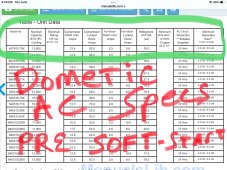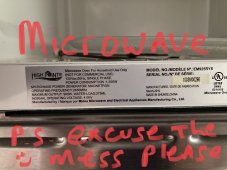LifeStudent
New Member
- Joined
- Feb 19, 2022
- Messages
- 18
Upgrading a camper trailer Solar system. Attached wiring diagram for your review, please!!!
So, here’s a little info to help out with any answers y’all feel like supplying.
On a trailer camper, she has 3 Seraphim 305W 60-cell Mono panels.
She has …
Reliable 2500W 12V 120VAC Inverter (I’m concerned about the reliability of this brand, so open for suggestions).
Epever 80A 200V (though I suspect the paperwork is wrong and it’s actually a 150V) Charge Controller. Model: Tracer8420AN
She started with 4 golf cart batteries and had trouble running her microwave at full power.
She has now purchased 3 Li Time 12V 200Ah LiFePO4 batteries with a 100A BMS to replace the others.
She’d like to be able to run the microwave at full power, and she’d like to be able to use her air conditioner on solar (and past sundown occasionally). Those are the only power hogs that will be used. I’ve added pics of those two appliances for reference. A soft-start is being installed on the AC unit as well.
On the wiring diagram, there are some dotted lines that depict how something WAS wired on the old system. They also indicate areas that need clarification before the wiring diagram can be complete. For the purposes of this safety check, those can be ignored.
Thank you for any helpful input!!
So, here’s a little info to help out with any answers y’all feel like supplying.
On a trailer camper, she has 3 Seraphim 305W 60-cell Mono panels.
She has …
Reliable 2500W 12V 120VAC Inverter (I’m concerned about the reliability of this brand, so open for suggestions).
Epever 80A 200V (though I suspect the paperwork is wrong and it’s actually a 150V) Charge Controller. Model: Tracer8420AN
She started with 4 golf cart batteries and had trouble running her microwave at full power.
She has now purchased 3 Li Time 12V 200Ah LiFePO4 batteries with a 100A BMS to replace the others.
She’d like to be able to run the microwave at full power, and she’d like to be able to use her air conditioner on solar (and past sundown occasionally). Those are the only power hogs that will be used. I’ve added pics of those two appliances for reference. A soft-start is being installed on the AC unit as well.
On the wiring diagram, there are some dotted lines that depict how something WAS wired on the old system. They also indicate areas that need clarification before the wiring diagram can be complete. For the purposes of this safety check, those can be ignored.
Thank you for any helpful input!!






